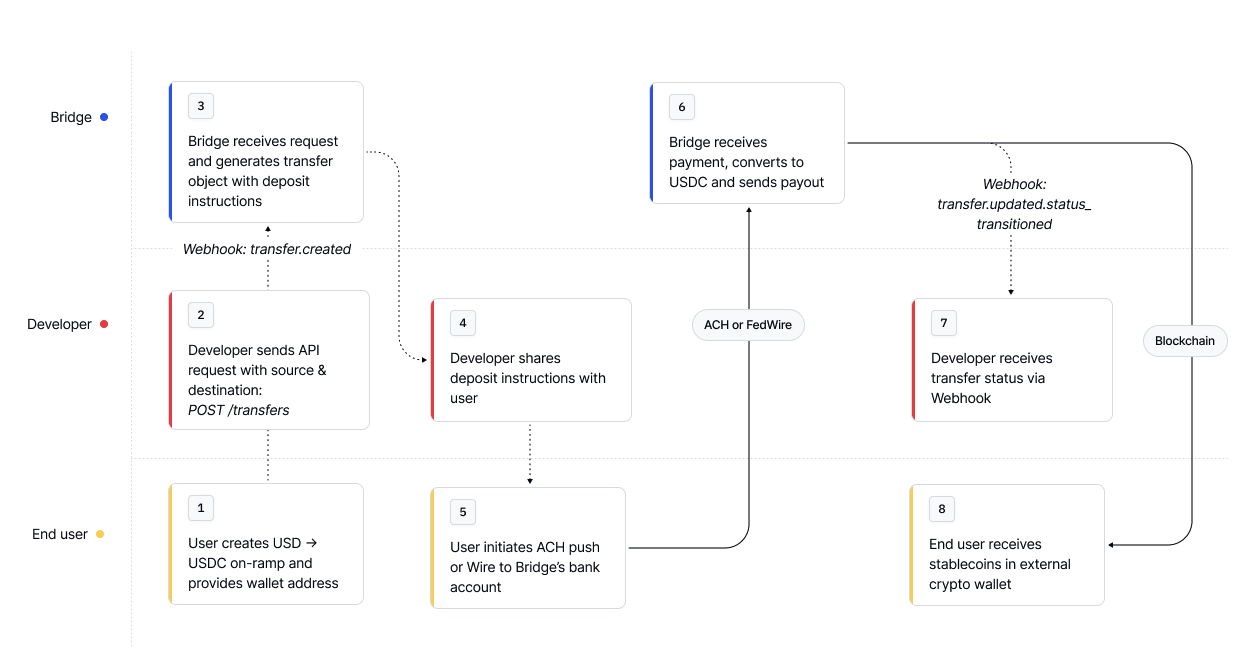Create a one-time payment
This guide will walk you through sending a one-time payment using Bridge's Transfer API. For this example, we'll be creating a one time payment from USD to USDC. With the Transfer API, you convert from any supported fiat currency to and from any supported crypto chain/currency. You can also use the Transfer API to take recurring payments.
Prerequisites
Before you begin, ensure you have:
- A Bridge account with API access
- Your API key (keep this secure!)
- At least one verified customer - see Create your first customer.
- Basic understanding of REST APIs
- Development environment set up
Understanding Bridge Transfers
Bridge transfers enable conversion between fiat and crypto across supported currencies and rails. There are three primary transfer types:
- Fiat → Crypto (aka onramps): Convert traditional fiat currency to cryptocurrency
- Crypto → Crypto: Exchange between different cryptocurrencies
- Crypto → Fiat (aka offramps): Convert cryptocurrency to traditional fiat currency
Here are the key concepts to a transfer:
- Source: Origin of funds (Bridge wallet, customer crypto wallet, bank account)
- Destination: Endpoint for funds transfer
- On Behalf Of: Customer identifier for compliance
- Amount: Transfer amount (can be flexible)
Transfer Flow

For detailed information, see Transfers.
Step 1: Create a transfer
Let's create a transfer for an onramp from a USD ACH deposit to a USDC Ethereum address.
curl --location --request POST 'https://api.bridge.xyz/v0/transfers' \
--header 'Api-Key: <API Key>' \
--header 'Idempotency-Key: <Unique Idempotency Key>' \
--data-raw '{
"on_behalf_of": "cust_alice",
"source": {
"payment_rail": "ach_push",
"currency": "usd",
},
"destination": {
"payment_rail": "ethereum",
"currency": "usdc",
"to_address": "0xdeadbeef",
},
"features": {
"flexible_amount": true // allows for any deposit amount
}
}'
Example response
{
"id": "transfer_123",
"state": "awaiting_funds",
"on_behalf_of": "cust_alice",
"source": {
"payment_rail": "ach_push",
"currency": "usd"
},
"destination": {
"payment_rail": "ethereum",
"currency": "usdc",
"to_address": "0xdeadbeef"
},
"source_deposit_instructions": {
"payment_rails": ["ach_push","wire"],
"currency": "ach",
"deposit_message": "BRGEXAMPLEMEMO",
"currency": "usd",
"bank_beneficiary_name": "Test Beneficiary",
"bank_routing_number": "123456789",
"bank_account_number": "987654321",
"bank_name": "Test Bank"
},
"features": {
"flexible_amount": true
},
"created_at": "2023-05-05T19:39:14.316Z",
"updated_at": "2023-05-05T19:39:15.231Z"
}
You can share the source deposit instructions with your customer. Your customer will then need to initiate an ACH deposit with:
- the destination routing number:
987654321 - the destination account number:
987654321 - with the a deposit message as:
BRGEXAMPLEMEMO
Once Bridge receives these funds, we'll look for the deposit message to find the payment.
Step 2: Monitor Transfer Status
Transfer states
When Bridge receives the deposit, we'll transition the transfer state to funds_received. From there, you can monitor the state until it's finally delivered. The transfer status when it's delivered is payment_processed. You can view the full breakdown of transfer states at Transfers.
Fetching Transfers status via API
You can use the Get a transfer endpoint to fetch the latest Transfer status.
curl --request GET \
--url 'https://api.bridge.xyz/v0/transfer_123' \
--header 'accept: application/json'
Funds received example
{
"count": 2,
"data": [
{
"summary": "A successful onramp transfer object",
"value": {
"id": "transfer_456",
"client_reference_id": "client_transfer_id_456",
"state": "funds_received", // transfer state
"on_behalf_of": "cust_alice",
"amount": "500.25",
"developer_fee": "0.0",
"source": {
"payment_rail": "ach",
"currency": "usd",
"external_account_id": "ext_123"
},
"destination": {
"payment_rail": "ethereum",
"currency": "usdc",
"to_address": "0x71C7656EC7ab88b098defB751B7401B5f6d8976F"
},
"receipt": {
"initial_amount": "500.25",
"developer_fee": "0.0",
"exchange_fee": "0.0",
"subtotal_amount": "500.25",
"gas_fee": "0.0",
"final_amount": "500.25",
"destination_tx_hash": "0xdeadbeef",
"url": "https://dashboard.bridge.xyz/transaction/00000000-0000-0000-0000-000000000000/receipt/00000000-0000-0000-0000-000000000000"
},
"created_at": "2020-01-02T00:00:00.000Z",
"updated_at": "2020-01-03T00:00:00.000Z"
}
}
]
}
{
"count": 2,
"data": [
{
"summary": "A successful onramp transfer object",
"value": {
"id": "transfer_456",
"client_reference_id": "client_transfer_id_456",
"state": "payment_processed", // transfer state
"on_behalf_of": "cust_alice",
"amount": "500.25",
"developer_fee": "0.0",
"source": {
"payment_rail": "ach",
"currency": "usd",
"external_account_id": "ext_123"
},
"destination": {
"payment_rail": "ethereum",
"currency": "usdc",
"to_address": "0x71C7656EC7ab88b098defB751B7401B5f6d8976F"
},
"receipt": {
"initial_amount": "500.25",
"developer_fee": "0.0",
"exchange_fee": "0.0",
"subtotal_amount": "500.25",
"gas_fee": "0.0",
"final_amount": "500.25",
"destination_tx_hash": "0xdeadbeef",
"url": "https://dashboard.bridge.xyz/transaction/00000000-0000-0000-0000-000000000000/receipt/00000000-0000-0000-0000-000000000000"
},
"created_at": "2020-01-02T00:00:00.000Z",
"updated_at": "2020-01-03T00:00:00.000Z"
}
}
]
}
Advanced: Monitoring using webhooks
You can set up webhooks to receive real-time notifications about transfer status changes. See guide for more details on setting up webhooks.
Example transfer webhook: payment_processed
{
"api_version": "v0",
"event_id": "wh_t8TAhPPYrRV2v8Asi9ed3sw",
"event_developer_id": "371983-uery-1238-1238971",
"event_category": "transfer",
"event_type": "updated.status_transitioned",
"event_object_id": "fecffc8b-ed5e-48ae-bd24-b36268330b32",
"event_object_status": "payment_processed",
"event_object": {
"id": "transfer_abc123",
"state": "payment_processed",
"amount": "50.0",
"currency": "usd",
"developer_fee": "0.0",
"client_reference_id": null,
"on_behalf_of": "cust_alice",
"source": {
"currency": "usdb",
"payment_rail": "bridge_wallet",
"bridge_wallet_id": "wallet_alice_usdb"
},
"destination": {
"currency": "usdb",
"payment_rail": "solana",
"to_address": "9uYxZmV1KxJn7oVPW6bLUhF3cGQsk8vvMf1sQdPE6K4"
},
"receipt": {
"url": "https://dashboard.bridge.xyz/transaction/transfer_abc123/receipt/receipt_xyz456",
"gas_fee": "0.0",
"exchange_fee": "0.0",
"developer_fee": "0.0",
"initial_amount": "50.0",
"subtotal_amount": "50.0",
"final_amount": "50.0",
"destination_tx_hash": "3gJH6oXpZUNgC1QLh8mXNPF92LtLKzHZj5eHuQrdQAgB"
},
"created_at": "2025-07-15T23:55:39.411Z",
"updated_at": "2025-07-15T23:55:58.645Z"
},
"event_object_changes": {
"state": [ "payment_submitted", "payment_processed" ]
},
"event_created_at": "2024-02-01T04:32:28.978Z"
}
Best Practices
- Clear Instructions: Provide customers with clear, step-by-step deposit instructions, including deposit messages
- Error Handling: Plan for various failure scenarios and customer communication
- Testing: Always test with small amounts before processing larger transfers
Next Steps
After successfully creating your first static template:
- Implement Webhook Processing: Set up comprehensive webhook handling for all transfer events
- Customer Communication: Build flows to notify customers of transfer status changes
- Error Recovery: Implement processes to handle failed transfers
Additional Resources
Updated about 3 hours ago
